Villains as Heroes
Back at the house commenting on a portrait hanging over the fireplace in the living room:

Nguyen Van Thieu, former President of South Vietnam (at right).
“Admiral Isoroku Yamamoto, he led the attack at Pearl Harbor. That was a great attack. That shook ‘em, didn’t it? He showed them. It was a wonderful attack. See, I was brought up to believe that the Japanese were particularly loathsome fascists. But somewhere along the line I read a book called The Brave Little Match Man, and it was about a magic tree that was cut down and made into matches. The spirit of the tree was in the matches. The Japanese soldiers in China took the matches with them, this precious light to bring civilization to China, all the good things – railroads, drugs… Anyway, at the end of the story the brave little match man sets himself off to blow up the dam to save the Japanese army and all the rest of this stuff. So it showed me that fascists could be heroes.”
“Actually, it’s not Admiral Isoroku Yamamoto , it is Nguyen Van Thieu and he led the Vietnamese air force for a while and was last President of Viet Nam.[1] He’s another hero of mine. These days he runs a liquor store in Los Angeles. Life is cruel.”
The gun collection:
“This is a Japanese Arisaka Type 99, this is an Enfield from the First World War, another one from the Second World War, and you can see the deterioration of the British workmanship. This is the M-1 carbine, but I put a different stock on it. That there is an old hollowed-out hand grenade. And here’s an SS bayonet. This is an old French bayonet from the Franco-Prussian war. And the British bayonet, here, goes with the Enfield. And up here, that’s a flak helmet, that’s a US army helmet.”
The living room has large book cases full of New York State Statutes. There are also, bound volumes of the Cryonics Society of New York newsletter and a collection of model ships; the British fleet in WW II.
“That’s Ming the Merciless, you remember him? From Flash Gordon.”
But all your heroes seem to be villains.
“No, they’re heroes.”

Ann DeBlasio’s dewar is consecrated by the Rev. Severio Mattei, as her husband Nick De Blasio (doorway), and CSNY mortician Fred Horn, look on, 15 August, 1969. Photo by Curtis Henderson.
“I used to have five people stored in tanks. Look, here’s a picture of a Catholic priest consecrating one of the tanks. I had them in Washington Memorial Park, up here in Coram, Long Island; the building where they stored peoples’ unclaimed (abandoned) ashes. Now, look at the photograph of this tank, this is the same one that’s lying out there now. We used it in the 21st Century show we did for Walter Cronkite, right there in that garage….”[2]

Film crew from the CBS-TV popular science program “The 21st Century,” filming in Curtis Henderson’s garage in 1968.
“There’s been so many radio shows, so many TV shows, that’s why I don’t expect anything anymore. You get a lot of phone calls, maybe a thousand, but out of that, you only get one person to sign up.”
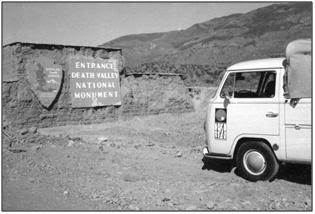
Cryo-Span truck in Death Valley, CA in 1969 (at right).
“Here, look at this picture: Death Valley. This was taken on our second big cross-country trip. We made that trip to see what was happening in cryonics at that time. Here’s my wife, see? And she used to complain I never took her anyplace – complained all the time.”
No Third Party Freezings
“The people I froze, they ended up different ways. Hearst, his son was doing research at University of Pennsylvania in Pittsburgh, and they cut his grant or something. He thought there was going to be a nuclear war, so he moved to New Zealand. So he couldn’t keep paying me to keep his father frozen anymore. And he was the best customer I had, because he had always paid his bills, and then he told me straight out, he’d had enough and it was time to bury the man, and that was it.”
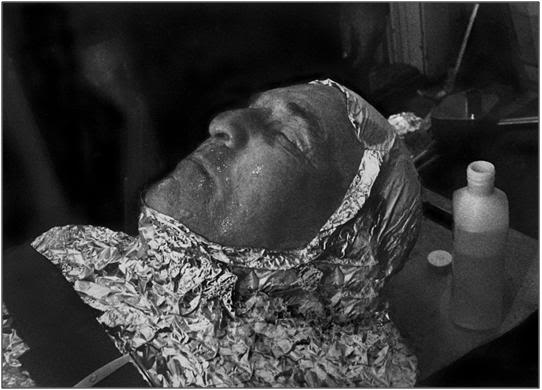
Paul M. Hurst, Sr., Photo by Curtis Henderson.
“Basically, all my suspensions were third-party situations. Somebody would come to me and say, ‘Dad’s died, I want to freeze him and I don’t care what it costs.’ So the man in the tank, you haven’t made any deal with him. You have no real obligation to the man in the tank. Well, I could see all these pitfalls, which is why I always had the relatives buy the tank. So when the trouble came, they could take the tank and go. Often I could see it was an uncomfortable situation, but if I didn’t freeze them, then Nelson would freeze them at half the price – because, of course, he wasn’t freezing them at all.
Curtis Henderson (left) and Fred Horn (right) inserting Paul Hurst, Sr., into MVE dewar in 1969 (below).
But never mind that, we’ll 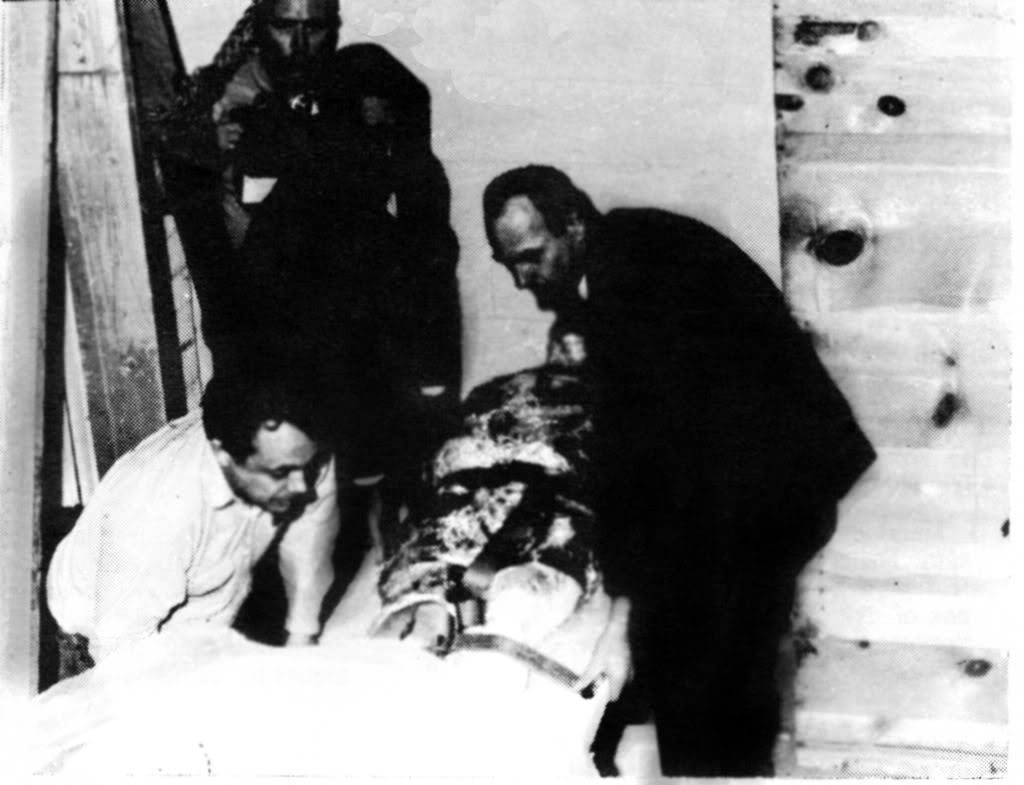 get into that, that’s a day’s discussion alone, and by the time it’s over I’ll be frothing at the mouth and they’ll have to put me in an iron lung. That’s a quart bottle of vodka story, right there. The point being that if it’s a third-party situation, you’re dealing with this third party. [3] The man in the can, he ain’t going to bother you, because he’s the man in the can. These people running around outside, their lives change, things happen to them. Pretty soon they start saying they never liked that old geezer anyway. See?
get into that, that’s a day’s discussion alone, and by the time it’s over I’ll be frothing at the mouth and they’ll have to put me in an iron lung. That’s a quart bottle of vodka story, right there. The point being that if it’s a third-party situation, you’re dealing with this third party. [3] The man in the can, he ain’t going to bother you, because he’s the man in the can. These people running around outside, their lives change, things happen to them. Pretty soon they start saying they never liked that old geezer anyway. See?
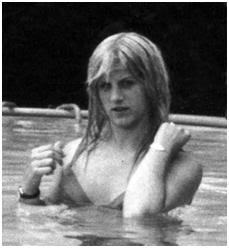
Diane (nee’ Pummel) Henderson in the Ettinger family swimming pool showing her Medic-Alert cryonics bracelet in the summer of 1966. Photo by Curtis Henderson.
Now you’ve got troubles, because they don’t like to admit that. I went through this with any number of people. They don’t want to actually say, ‘Oh, I don’t want to keep him frozen, pop him in the ground.’ They start with complaining that I’m charging too much, the liquid nitrogen level isn’t high enough, and why didn’t I get them on the last TV show. That was one of the biggest complaints. They come here and see people making a TV show, and they complain if I don’t get them on it. My wife used to complain, too. She hated female reporters, she’d always make snide, jealous remarks, and so then she had to read in the paper that she was Mr. Henderson’s plump, middle-aged wife. I told her she had to stop insulting these female reporters. But – the third-party situation – we didn’t ever get all the money up front. That was a mistake.

Steven Mandell’s Cryo-Care CC-111 Cryocapsule being filled with liquid nitrogen at Washington Memorial Park Cemetery on Coram, L.I., New York. Mandell’s dewar was #005. Photo by Curtis Henderson.
“Meanwhile we were laying out money for dry ice, rental on the place where the bodies were being temporarily stored. And the relatives were starting to find reasons why not to go ahead. The tension grows, and at some point – actually, much as I hate Nelson, in a way he did me great favors. He took these people away from me! He stole that tank. You know, I clapped when he loaded it on a truck and ran out of here. Mandell’s mother had no intention of paying, she never did pay anything. We had paid about $2,000 for the liquid nitrogen to keep that tank cold. And you had to run that pump day and night. Every time the power utility gave us a brownout, not only would the pump stop and lose the vacuum, but the end of the tank would fall off! I had C-clamps on it so it wouldn’t fall off. When the power failed and the vacuum pump quit running, the suction from the vacuum in tank would suck the oil out of the vacuum pump. All that oil loaded with crap from the air would be pulled into the vacuum space, and no amount of valves or anything seemed to stop that. It was a horrendous tank. Nelson took that one.”[4]
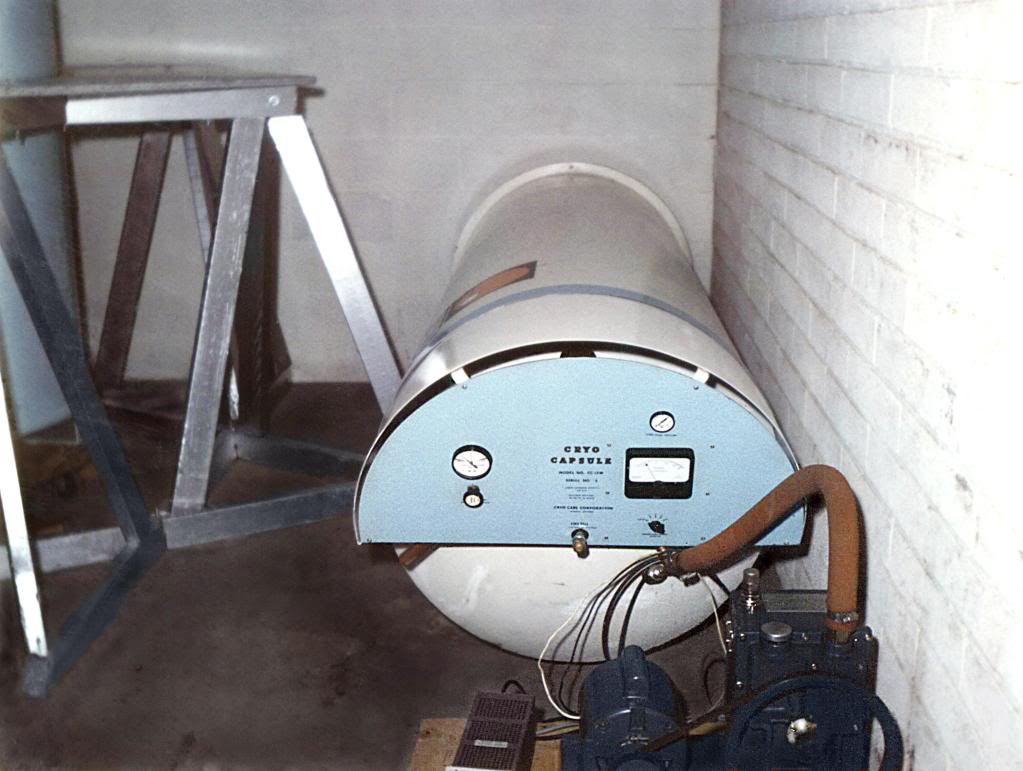 Long view of Steven Mandel’s Cryo-Care dewar in 1968, showing the vacuum pump required to run continuously in order maintain an adequate vacuum. Photo by Curtis Henderson.
Long view of Steven Mandel’s Cryo-Care dewar in 1968, showing the vacuum pump required to run continuously in order maintain an adequate vacuum. Photo by Curtis Henderson.
“We used to sit here at night, when things really got bad, and talk about the future of how we would do things, and out of that came the policy of freezing only people who were signed up and had made preparations. Now at least you’ve got a piece of paper saying he wants to be frozen. The other way, you’ve got a man’s wife, five years down the line saying, ‘Oh, he never knew anything about cryonics and I only did this in a moment of grief, and these fraudulent people came along and told me they were going to bring him back’ – and the woman at that moment has the legal say, and the cryonics company doesn’t have anything.

The facility at Washington Memorial Park (at right) was extremely small and cramped. Few pictures showing the entire facility are now known to exist – none of high quality.
“In the closing days of our being at Washington Memorial Park De Blasio got unhappier and unhappier about things. The liquid nitrogen level wasn’t high enough, the cigarette butts on the floor, and this and that – and he got in touch with Nelson. Meantime, he’d gotten his share of the $200,000 settlement from the hospital that killed his wife. So now he had money. Nelson talked him into building a facility over here in Mount Holiness cemetery in Jersey, and putting the tank over there. So he took his tank and put it over there.
The second interview with Henderson was conducted on February 8, 1992. The following text was typed while Curtis talked:
[Henderson’s brothers are named Donald and Lynn. Donald, the youngest, lives in Edwina, PA, he is in the Merchant Marine and participated in a military sealift bringing tanks back from the Persian Gulf. Lynn, the Trotskyite, is the middle brother, lives in Minnesota.]

Curtis Henderson (left) and his brother Lynn Henderson (right) at Lynn’s home in Minnesota during the summer of 2006 ( at right).
“Lynn used to work for the railroad and is retired now. Once or twice a year I call to tease him about the demise of world socialism, and when he gets into a screaming rage, I hang up.”
Donald Henderson was Curtis Henderson’s father. His mother was named Eleanor.
“My father died around 1966, before I got into cryonics. Died of emphysema and to the last day of his life he was sneaking cigarettes, like they all do.”
“The EMT course I took to get in Mike Darwin’s good graces really gets to you. You think of the people you’ve known, and the things they’ve died of and you see the inevitability, and your own mortality.”
“We bought this house in 1960. My wife found this house and it cost $14,999 and I thought for that kind of money, you can buy anything. I started building the bomb shelter pretty much after I bought the house. Lynn went to Cuba and came back with all these tales about how wonderful the revolution had been, and when I heard that, I built the shelter.”
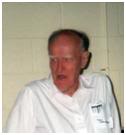
Robert Duncan Enzman, Ph.D., at the Cryonics Institute ~2008 (at right).
The scientist at Raytheon who set us up with the New York Academy of Sciences for the Conference was Dr. Robert Enzmann and he had a sister named Jane. Robert Enzmann was kind of eccentric, had three PhD’s, and was also the biggest liar that ever lived; claimed he was freezing bodies in Boston. But his sister Jane, well, in those days a woman doctor looked like a Russian babushka, but not Jane. She was about 30 or 35, but she looked about 18 with long blond hair. She liked to party at Trader Vic’s…she really didn’t practice medicine much.”
“We used to drink together, and she also had free samples of every dope you can imagine. She kept the pills in a big bowl so you could grab a handful, help yourself. I’d go there and wake up three days later with my car towed away and my head as big as a balloon. I had a maid out on Long Island to take care of the kids, but the maid was more trouble than the kids.”
“Jane was really into alcohol and drugs. She used to have 2 parrots who said things like ‘I never did this before.’ Jane would sign up for expeditions; she went to India and got one of these intestinal parasites, and they cured it with one of those drugs that damage the liver. At that point she should have given up alcohol and drugs. But she didn’t. I got married to Diane, my second wife, mostly because Jane wasn’t the housewife type.”
End of Part 4
Footnotes
[1] Nguyen Van Thieu, was the penultimate president of South Vietnam a ruthless but competent general. Elected in 1967, for eight years he was the lynchpin of the US’s fated war in South Vietnam. Presiding over the country during the bloodiest period of the war, he stood at the center of the storm of world affairs his name and photo constantly in the media. When Thieu took command of the Army of the Republic of Vietnam (ARVN) he began executing deserters and turned the ARVN into a credible fighting force. Thieu, leading the ARVN, took back Hue. But alas, this was 1972 and Nixon signed the Paris Peace Accords in 1973. Thieu’s picture replaced Adolf Hitler’s over the fireplace in the Henderson home sometime in 1973. MD
[2] The 21st Century was a popular TV future oriented science program. The cryonics episode aired 24 March, 1968 on CBS TV. MD
[3] Actually, two of CSNY’s patients wanted cryonics and made efforts to pay for it and executed the necessary paperwork. Mandell had an insurance policy but was not past the 2-year contestability period and he joined CSNY and filled out the very early paperwork. Dostal had executed all of the CSNY paperwork and had a will and trust – I saw these documents myself at the time in 1972. Both Beverly and her mother insisted that they had had numerous conversations where they all agreed that they would be cryopreserved when they died. This was not the case for Ann DeBlasio and Paul Hurst. MD
[4] The Cryo-Care unit needed a costly automatic shut-off vacuum valve for power failures. It closes the pump off from the vacuum in the space between the inner and outer cans. If you don’t have this, the vacuum in the annulus of the dewar sucks virtually all of the oil out of the vacuum pump and into the Superinsulation™. Once this happens the unit has to be completely reworked. Now, your vacuum really is dependent upon continuous pumping! Any failure or disconnection of the pump leads to vacuum failure in a few hours, at most. Henderson kept Mandell’s dewar half full. Twelve hours or so after Nelson disconnected the pump to move the dewar, Mandell was at or near 0oC and on his way to thawing out. I’ve no doubt Steven had thawed or nearly thawed by the time he reached California. Ironically, Nelson took the wrong pump – a very poor quality (and old) roughing pump which could not have maintained an efficient vacuum on the Cryo-Care dewar. In fact, Curtis bought the larger pump not just as a back-up, but because the smaller pump could not keep the vacuum hard after the contamination of the annulus. That model of CryoCare dewar, the CC-111 full of LN2 would be empty of nitrogen with the patient up to between -50 to -80 o C in 12 hours based on failure tests done at Cryo-Care. MD
